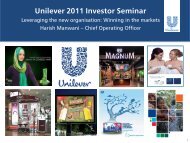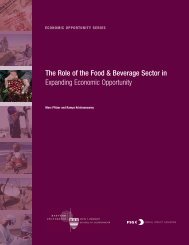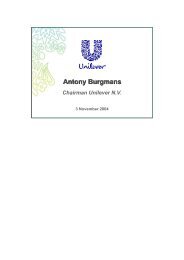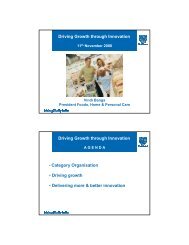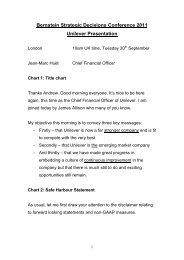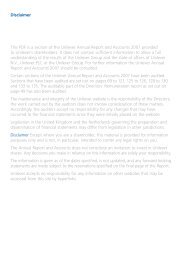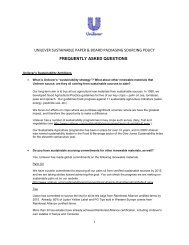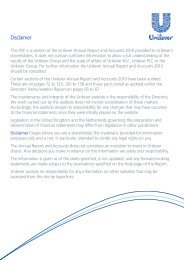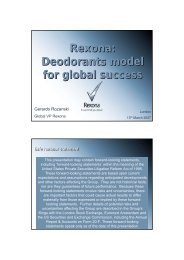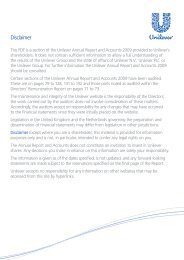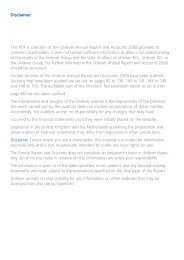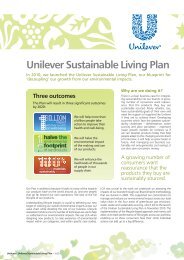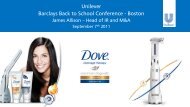meeting everyday needs of people everywhere Annual ... - Unilever
meeting everyday needs of people everywhere Annual ... - Unilever
meeting everyday needs of people everywhere Annual ... - Unilever
You also want an ePaper? Increase the reach of your titles
YUMPU automatically turns print PDFs into web optimized ePapers that Google loves.
12 <strong>Unilever</strong> <strong>Annual</strong> Review 1998 Business Overview<br />
<strong>Unilever</strong>’s results are published in the currencies<br />
<strong>of</strong> its two parent companies, the guilder and<br />
the pound sterling. Fluctuations between these<br />
currencies can lead, as in 1998, to different trends<br />
for the same business. This is why we usually<br />
comment on performance at constant exchange<br />
rates (that is, the same rates as in the preceding<br />
year), eliminating one variable over which we have<br />
little control. We also use constant exchange rates<br />
for the management <strong>of</strong> the business. In order to<br />
make the comparison with the previous year clear,<br />
and unless otherwise stated, our comments<br />
throughout this Review are based on trends at<br />
constant exchange rates and exclude the pr<strong>of</strong>it<br />
on the disposal <strong>of</strong> our chemicals businesses and<br />
the loss on the disposal <strong>of</strong> fixed assets in 1997.<br />
Results<br />
Overall turnover decreased by 2% in 1998. However, excluding the<br />
effect <strong>of</strong> the sale <strong>of</strong> our chemicals businesses in 1997, turnover in our<br />
continuing operations rose by 2% to £29 036 million. Underlying<br />
volume growth <strong>of</strong> 2% was a little more than half the rate achieved<br />
in 1997. This was due to two factors: the impact <strong>of</strong> poor weather<br />
in Northern Europe on ice cream sales, and our slower progress<br />
in developing and emerging markets.<br />
Operating pr<strong>of</strong>it in our continuing business, excluding exceptional<br />
items, was £3 095 million. This represents an 11% increase, with<br />
operating margins as a percentage <strong>of</strong> turnover strengthening by almost<br />
one percentage point to just under 11%. On the same basis, net pr<strong>of</strong>it<br />
for the year <strong>of</strong> £2 059 million increased by 16% on 1997. This strong<br />
pr<strong>of</strong>it growth was achieved after increased spending on marketing.<br />
Exceptional items produced a net benefit <strong>of</strong> £86 million in 1998<br />
compared with a charge <strong>of</strong> £565 million in 1997. This £86 million<br />
includes restructuring costs <strong>of</strong> £177 million, mainly focused in Europe<br />
and Asia and Pacific, which were more than <strong>of</strong>fset by pr<strong>of</strong>its on<br />
disposals, principally the sale <strong>of</strong> Plant Breeding International.<br />
Restructuring programmes in Europe and North America continued<br />
to provide substantial cost savings. Overall productivity, based on sales<br />
per employee, improved by 6% in 1998 (1997: 5%).<br />
At current exchange rates £227 million was spent on acquisitions<br />
in 1998 and £444 million received from disposals. The effect <strong>of</strong><br />
acquisitions on turnover and operating pr<strong>of</strong>it was £133 million and<br />
£7 million respectively. Twenty businesses were acquired and 24<br />
were sold.




